Key Findings
Historically, the LGBT+1 community has faced mental health and substance use problems at higher rates than their non-LGBT+ peers. The COVID-19 pandemic, which has disrupted the lives of people across the globe, has negatively impacted LGBT+ people’s mental health in disproportionate ways. In this data note, we pull together data from nationally representative surveys, adding to a small but growing evidence base on the impact of the pandemic on LGBT+ people.
- LGBT people reported the COVID-19 pandemic negatively impacted their mental health both more widely and more severely than their non-LGBT peers. They report that their sleep, appetite, and temper were negatively impacted at higher rates than non-LGBT people. They also report that they were more likely to seek out mental health care during the pandemic than non-LGBT people, including via telemedicine.
- A range of factors may contribute to these mental health disparities among LGBT+ people during the COVID pandemic, including different work, life, and health care experiences. LGBT+ people more commonly report quitting a job because of COVID-19, taking time off work because of becoming ill with COVID-19 or quarantining, or taking time off work to care for a family member who was sick with COVID-19 or quarantining than non-LGBT+ people. Given that LGBT+ have lower-incomes than their non-LGBT+ peers, disruptions in employment could be especially challenging for families and harmful to mental health.
- Another factor that may drive these disparities is LGBT+ people’s higher rates of mental health and substance use problems pre-pandemic, including those related to more common experiences of stigma and discrimination compared to their non-LGBT+ peers. These underlying experiences could have made LGBT+ people more vulnerable to stress during the pandemic.
- Despite LGBT+ people reporting accessing mental health care at higher rates than non-LGBT+ people, many still face barriers, particularly financial ones, to getting the care that they need. LGBT+ people are more likely to report they could not afford mental health care and say they face challenges with medical bills than their non-LGBT peers. Other reported roadblocks include problems getting appointments and negative provider experiences.
Taken together, these findings may help to identify and inform opportunities to address and mitigate mental health disparities among LGBT+ people. These could include adopting culturally appropriate policy solutions and approaches to engaging the community, as well as efforts to address wider, systemic factors that drive stigma and discrimination.
Introduction
Historically, the LGBT+ community has faced mental health and substance use problems at higher rates than their non-LGBT+ peers and experiences during the COVID-19 pandemic have been no exception. The pandemic has negatively impacted LGBT+ people’s mental health in disproportionate ways. Pulling together data from three nationally representative surveys in this area, we explore a range of factors related to LGBT+ people’s mental health during the pandemic including assessment of mental health, access to and affordability of mental health services, and underlying experiences of stigma, discrimination, and negative encounters with health care providers.
Data in this analysis comes from: KFF’s monthly COVID Vaccine Monitor, KFF’s Women’s Health Survey, and new KFF analysis of publicly available Survey of Household and Economics and Decisionmaking (SHED) data from the Federal Reserve.
The Impact of COVID-19 on LGBT People’s Mental Health and Care Seeking
LGBT individuals report that worry and stress related to the COVID-19 pandemic negatively impacted their mental health more often and more severely than non-LGBT people. These negative mental health impacts were especially pronounced for all people before vaccines were widely available. The KFF COVID-19 Vaccine Monitor found that in the December 2020/January 2021 period, three-quarters of LGBT people (74%) reported that worry and stress from the pandemic negatively impacted their mental health compared to half (49%) of non-LGBT people. This includes about half of LGBT people (49%) who said the coronavirus was having a “major impact” on their mental health, twice the share of non-LGBT individuals who reported the same (23%) (Figure 1).
While the share reporting negative mental health impact of the pandemic fell for both groups in July 2021, a time of widely available vaccination and partial reopening, LGBT people continue to report the pandemic has negatively impacted their mental health both more widely and more severely than non-LGBT people. In July, six in ten LGBT people reported that the pandemic negatively impacted their mental health, about half (31%) of whom say that the impact has been major. By comparison, 37% of non-LGBT people reported a negative mental health impact in this period, 17% of whom say that the impact was major (Figure 1).
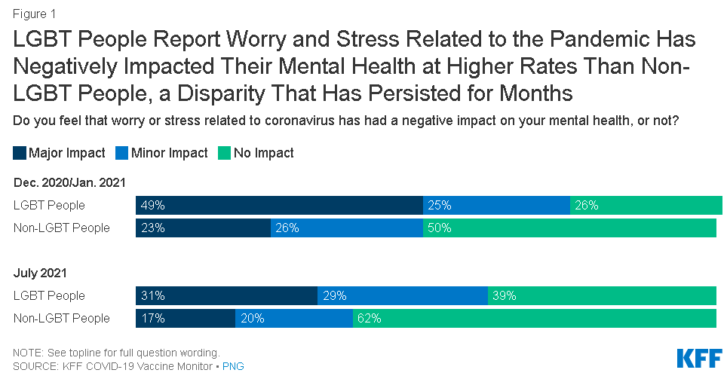
Specifically, compared to non-LGBT people, larger shares of LGBT people say worry or stress related to the coronavirus caused them to experience difficulty with sleep (39% v. 21%), problems with their appetite (41% v. 18%), and difficulty controlling their temper (23% v. 10%) in the past two months. They report similar rates of headaches or stomachaches, worsening chronic conditions (e.g. blood pressure or diabetes), and increased alcohol or drug use. LGBT people are more likely to report that they have experienced at least one of these impacts than non-LGBT people (55% v 34%) (Figure 2).
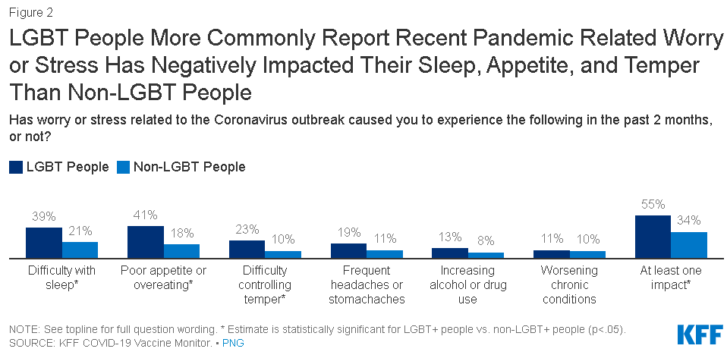
A range of factors may contribute to these mental health disparities among LGBT+ people, including their different circumstances during the pandemic. For example, the 2020 KFF Women’s Health Survey found larger shares of LGBT+ people reported having to quit a job for a reason related to COVID-19 compared to non-LGBT+ individuals (15% v. 7%). Additionally, 19% of LGBT+ people report taking time off work because of personally becoming ill with COVID-19 or quarantining, compared to 11% of non-LGBT+ individuals. One in ten (10%) LGBT+ people report taking time off work to care for a family member who was sick with COVID-19 or is quarantining (v. 5% of non-LGBT people) (Figure 3). While these factors could be stressful for any individual, given that LGBT+ people tend to be lower income than their non-LGBT+ peers, disruptions in employment could be especially challenging for families and harmful to mental health.
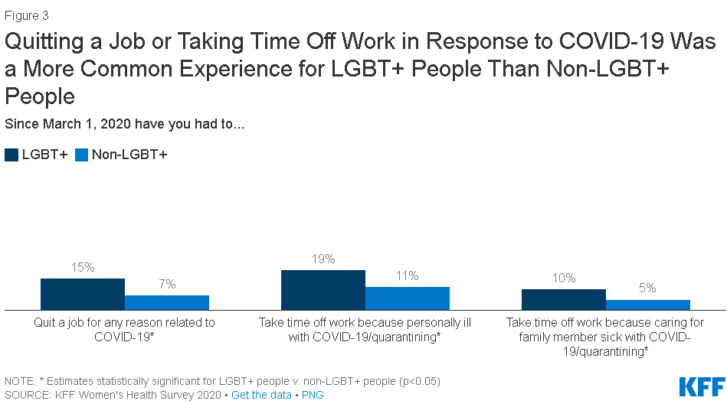
In addition, LGBT+ people faced higher rates of mental health and substance use problems pre-pandemic, which may be related to common experiences with stigma and discrimination. KFF analysis of 2020 Survey of Household and Economics and Decisionmaking (SHED) data reveal that 19% of LGBT+ people report experiencing discrimination or unfair treatment in the past 12 months versus 9% of non-LGBT+ people (Figure 4). These experiences with unfair treatment and discrimination were similar prior to and during the pandemic but the underlying stress associated with them could have made LGBT+ people more vulnerable to pressures related to the pandemic.
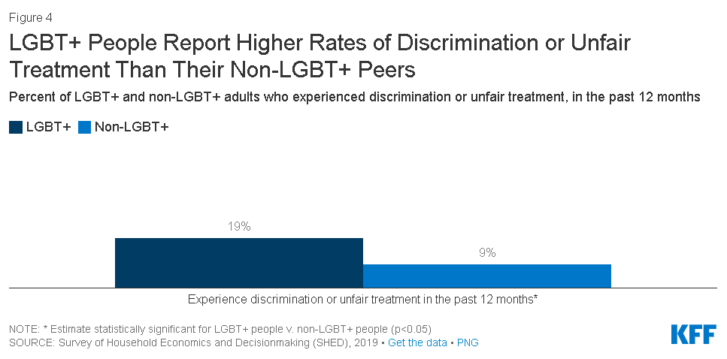
LGBT+ people also report seeking mental health care during the pandemic more than non-LGBT+ people. One in four (25%) LGBT+ people report seeking mental health care because of the pandemic, compared to 1 in 10 (12%) non-LGBT+ people, potentially reflecting their higher reported needs in these domains (Figure 5).

Additionally, LGBT+ people reported using telehealth more widely since the pandemic began than non-LGBT+ people (49% v. 34%) and among LGBT+ people who reported COVID era telehealth use, 25% say it was for mental health services, a higher share than non-LGBT+ telehealth users (14%) (Figure 6).
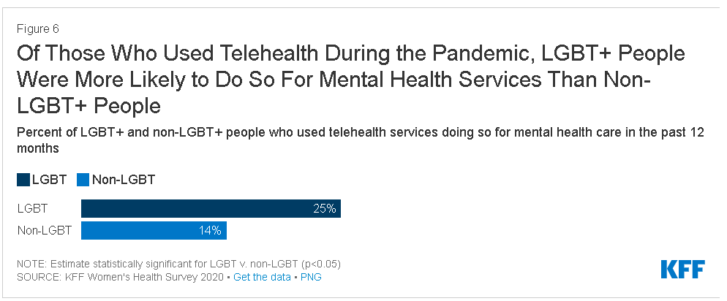
Barriers to Mental Health Care
Even as LGBT people have a greater need for mental health care during the pandemic, and report seeking such care at higher rates, all those who require mental health services may not be receiving them. SHED data reveal that in 2020, one-in-five (19%) LGBT+ people say they could not afford mental health care or counseling during the past 12 months compared to a smaller share of non-LGBT people (5%) (Figure 7). LGBT+ people’s lower income levels and higher rates of pandemic related employment disruptions compared to non-LGBT+ peers could make accessing and affording mental health care especially difficult for this group.
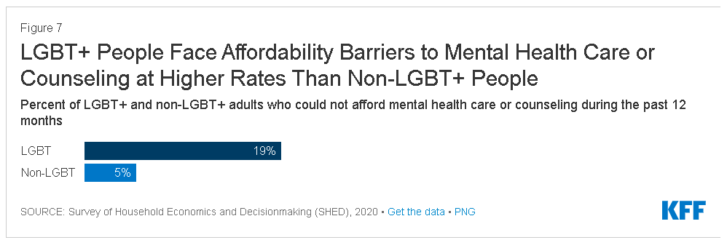
Indeed, 30% of LGBT individuals report trouble paying medical bills in the past year, compared to 19% of non-LGBT individuals (Figure 8). Of LGBT people who had trouble paying medical bills over half (58%) attributed that trouble, at least in part, to the COVID-19 pandemic.
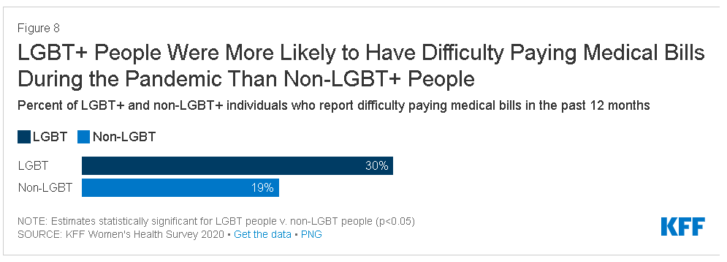
In addition to financial challenges, difficulty in obtaining appointments during the pandemic may also present a barrier. Nearly one-third (29%) of LGBT+ people said they were unable to get a health care appointment during the pandemic (not limited to mental health services), similar to the share among non-LGBT+ people (25%).
Negative provider experiences may also deter LGBT+ people from getting the care they need. Compared to non-LGBT people, LGBT+ people are more likely to report a provider has not believed they were telling the truth (16% v. 8%), suggested they were to blame for a health problem (13% v. 8%), assumed something without asking (21% v. 11%), and dismissing their concerns (29% v. 16%). Altogether, over one-third (36%) of LGBT+ people reported at least one of these negative experiences with a provider, compared to fewer than one in five (22%) non-LGBT+ people. (Figure 9)
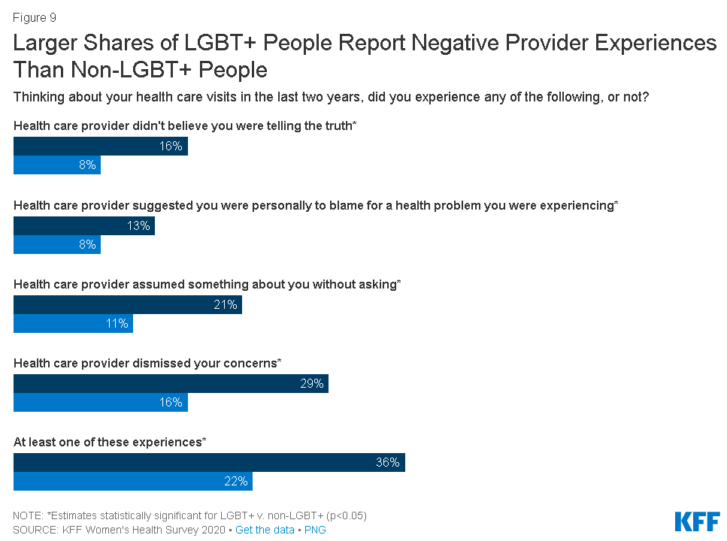
Implications
Larger shares of LGBT+ people experienced negative mental health effects from the COVID-19 pandemic than non-LGBT people. While LGBT+ people were more likely to report seeking mental health care during the pandemic, not all those who need services are obtaining them. Many report barriers to receiving care, particularly related to affordability. However, difficulty getting appointments during the pandemic may also play a role, as might negative past provider experiences. Experiences of stigma and discrimination were widespread among LGBT+ people prior to the pandemic and these underlying disparities could make weathering pandemic related stress more challenging. These findings are important both given the mental health disparities LGBT+ populations have traditionally faced and as the pandemic created new stressors disproportionately impacting the community. As such, targeted and culturally appropriate policy solutions and approaches to engaging the LGBT+ community would be beneficial. Additionally, addressing the wider, systemic factors that drive stigma and discrimination may help to mitigate these disparities.
Article From: KFF
Author: Lindsey Dawson Follow @LindseyH_Dawson on Twitter , Matthew McGough , Ashley Kirzinger Follow @AshleyKirzinger on Twitter , Grace Sparks Follow @gracesparks on Twitter , Matthew Rae Follow @matthew_t_rae on Twitter , Greg Young , and Jennifer Kates Follow @jenkatesdc on Twitter

